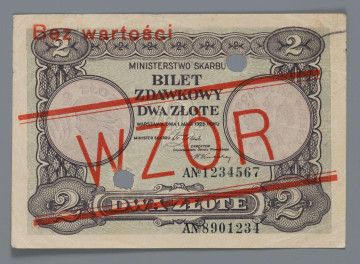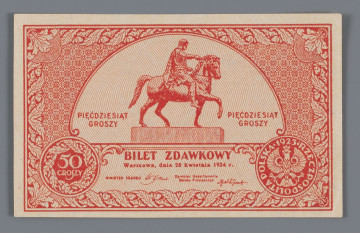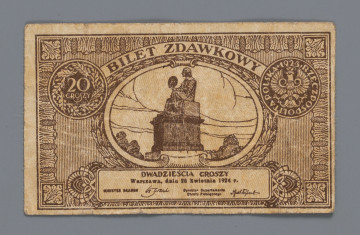
2 zlotys – a template
1925
National Museum in Lublin
Part of the collection: Paper money during the Second Polish Republic
The interwar period was a period of struggle to stabilise the economic situation in Poland. The unification of the country, consisting of lands belonging to three partitioning powers and three different economic systems, was not easy. The need for an armed struggle to maintain the newly-regained independence exacerbated the difficulties. Inflation became a phenomenon accompanying the people of Poland for a long time. Władysław Grabski's economic reform of 1924, involving, among other things, the introduction of the zloty as the country's currency, stabilised the exchange rate, but this had the side effect of increasing unemployment. The social unrest caused by this, coupled with a crop failure in 1924, and growing tensions in economic relations with Germany, resulting in the so-called tariff war in mid-1925, forced the government to increase money issues. An additional problem was the shortage of coins. In this situation, just as at the introduction of the currency reform of 28 April 1924, it was decided to introduce pass tickets with the face values of 2 and 5 zlotys. They were designed by Wacław Borowski. The tickets bore the date of 1 May 1925, and on the obverse, there were images of the replaced coins. The five-zloty ticket bore the image of a silver coin called ‘Constitution’, after the personification of Poland depicted on it, who received a book with this title from a young man. Legal turbulences led to a situation in which the silver content of a test series of these coins exceeded their face value. As a result, they were not circulated, and the test series ended up in the hands of collectors. The situation was different with the pass ticket, which was supposed to replace it. It entered the hands of Polish citizens on 1 July 1925. It was withdrawn from circulation on 30 June 1929, and the final date for replacement was set for 30 June 1931.
The design of the pass tickets from 1925 assumed an image of the replaced coin on the obverse. The two-zloty ticket featured both the obverse and reverse of the coin. In the case of the five-zloty ticket, only the reverse of the silver five-zloty coin was depicted.
In the case of a model ticket, two red diagonal lines were placed on both sides of the ticket, together with the inscription ‘MODEL’ between them and the annotation: ‘No value’, placed in the upper left corner.
Leszek Poniewozik
Author / creator
Dimensions
cały obiekt: height: 128 mm, width: 84 mm
Object type
paper money
Technique
Material
paper
Creation time / dating
Creation / finding place
Owner
The National Museum in Lublin
Identification number
Location / status

1925
National Museum in Lublin

1924
National Museum in Lublin

1924
National Museum in Lublin
DISCOVER this TOPIC
National Museum in Lublin
DISCOVER this PATH
Educational path